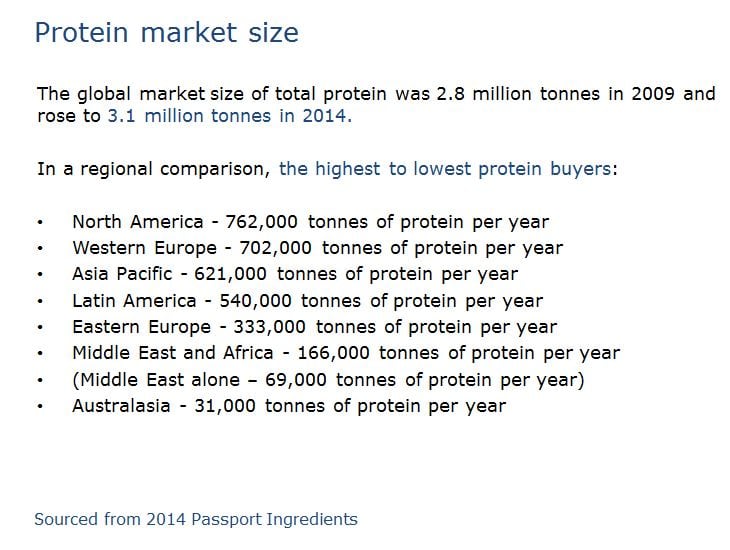So says a recent Euromonitor International report that found western European consumed 49 g of protein per day compared to 38 g in the US and only 9 g in the Asia Pacific.
Germany, which has the world’s most advanced ‘protein brod’ (bread) market, leads the way at about 53 g of protein a day for its citizenry, followed by Sweden (52 g), the Netherlands (50 g), Belgium (50 g) and Norway (49 g), according to 2014 Euromonitor data presented at Vitafoods Europe in Geneva last year.
Some of this is ‘health halo’ consumption but science-backed protein health benefits like muscle development and maintenance are backed in the EU as health claims, although another well-documented area – satiety and weight management is not at this stage.
The fact that bread is the dominant form of protein delivery, in western Europe at least, may surprise as it is most typically considered a carbohydrate carrier, but a typical loaf contains 8 g of protein per 100 g.
Western Europeans consumed on average 16 g of protein from bread, more than double the next source – chilled processed foods at 6 g. Milk and cheese were the next highest, with each category contributing 5 g per day.

In the snacks area, protein is increasingly being formulated into the likes of crisps and bars and being used as a demonstrative means of marketing.
"Protein delivery is evolving in response to consumer demand for less processed foods, it is now appearing in more natural forms, particularly plant derived, such as pea and rice protein," said Mintel global food and drink analyst, Jodie Minotto.
"Furthermore, rather than simply being delivered in high amounts, more moderate protein levels are appearing in a spate of snack bar launches targeted at mainstream consumers and children."
Hit the bar

She added: "Research indicates that a significant minority of consumers are very open to making snack bars a bigger part of their meal times, either as a complete replacement or as a dessert.
"As such there is a role for snack bars to bundle moderate amounts of protein into a formulation that offers balanced nutrition for these occasions."
Protein foods aimed at ageing populations with greater protein needs to combat issues like sarcopenia (muscle wasting) was growing into a market Euromonitor valued at €6.25bn.
"The market potential among this group of consumers is enormous; if 100% of the population aged 65+ in north America and western Europe spent €4.5 a month on high protein milk drinks, then retail value sales would reach €14bn+ by 2019," Euromonitor said.
The Asia Pacific will provide the greatest growth in various protein forms in the years until 2019, growing almost six times faster than the next biggest mover, latin America.
Soy protein will exhibit the greatest growth followed by casein, whey, other vegetable proteins and milk-sourced proteins.

Euromonitor said protein tonnage would stay flat in Europe until 2019 but Asia Pacific would move from 621,000 tonnes in 2014 to 786,000 tonnes in 2019.
Animal versus plant versus insect

Animal-sourced proteins like casein, whey, gelatin, protein hydrolysates, egg white, milk protein concentrate and isolate, hydrolysed keratins, albumin and lactoferrin amounted to 1.2m tonnes globally in 2014.
In the same period about 2m tonnes of vegetable proteins including soy concentrates and isolates, gluten (excluding pea protein) were sold.
New protein source on the block, insects, are set to stake a significant place in the protein supply chain, given levels of consumer acceptance, education and regulatory change, Euromonitor said.
The next 'Big Greek'
It forecast big things for the category going forward, especially as established food players through their weight behind protein.
"With major players in western markets, including General Mills, Kellogg and Mars, all launching high protein variants of their mega-brand products and sports nutrition retail value sales reaching €9bn in 2014, it is clear that the high protein trend has moved from niche to the mainstream."

But it noted one star sub-category - Greek yoghurt - while still in growth overall, was showing signs of slowing down in some markets like the US.
Fermented milks like skyr and kefir could be candidates to be the next 'Big Greek'.
"They offer excitement to the dairy aisle and tick three unique selling points proven successful in the past: origin, heritage and nutrition."
